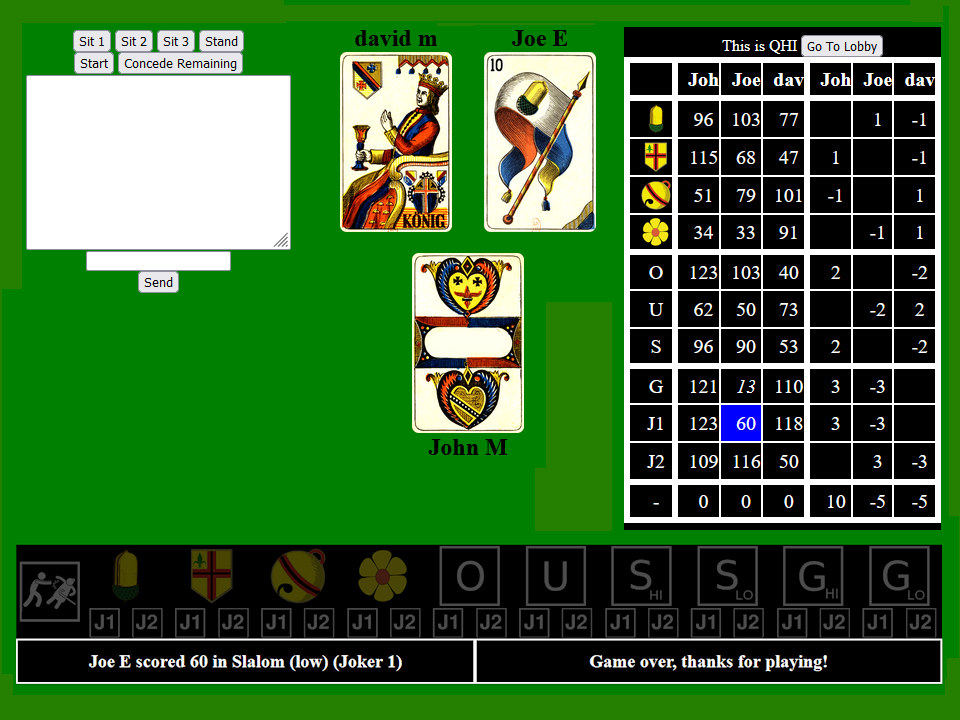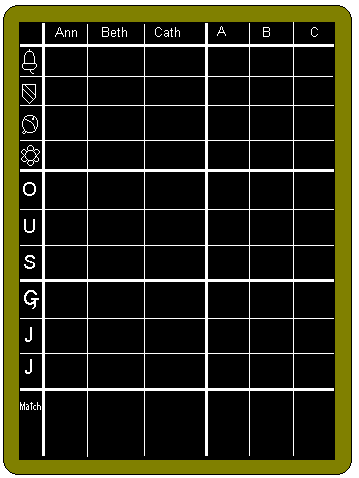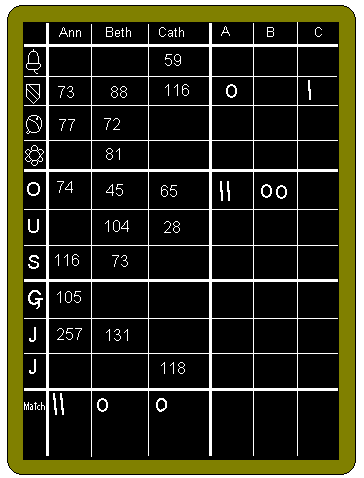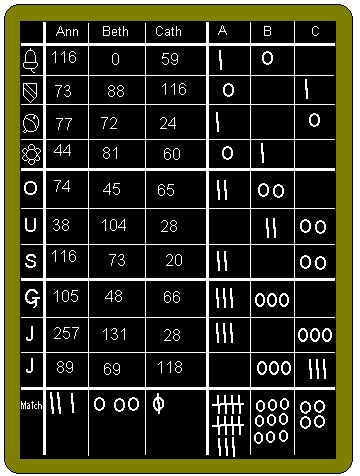Coiffeur-Schieber Jass

This compendium game consisting of a series of Jass variants in a sequence chosen by the players is best known in Switzerland as a four-player partnership game, but there is also an excellent 3-player version where in each deal one player chooses which game to play alone against the other two in partnership.
Class: Jass group
Related games: Schieber Jass
Region: Switzerland
- Introduction
- Coiffeur-Schieber for 3 players
- The Slate
- Rules of Play
- The Bidding
- Scoring
- Advice on Skilful Play
- Coiffeur Schieber for 4 players
- Variations
- The Name Coiffeur
- Software and Online Games
Introduction
Coiffeur-Schieber is a game of the Swiss Jass group. Nick Wedd here describes an excellent version for three players, which appeared in the book Vom Zweier-Sidi zum Dräck-Jass: V mal X Jassideen by Peter Hammer, Orlando Eisenmann and Max Ruh (Verlag M & T-Helvetica 1988).
Coiffeur-Schieber is better known in Switzerland as a game for four players, either in fixed partnerships or all against all. The details are given later.
Coiffeur-Schieber for 3 players
Each player has to play each of a number of different contracts in the course of the session, which consists of thirty hands.
It is played with a 36-card jass pack. There are four suits: acorns, shields, flowers, and bells. In each suit, there are nine cards: ace (or sow), king, ober, under, banner, 9, 8, 7, 6. If you cannot obtain such a pack, you can play it with a bridge or poker pack, using queens for obers, jacks for unders, 10s for banners, and discarding cards smaller than 6s. In North America, Jass cards and equipment can be obtained from TaroBear's Lair.
The rank of the cards (followed by their point values in brackets) within each suit is: Ace(11), King(4), Ober(3), Under(2), Banner(10), 9(0), 8(0), 7(0), 6(0). However, when there is a trump suit, the rank within the it is: Under(20), 9(14), Ace(11), King(4), Ober(3), Banner(10), 8(0), 7(0), 6(0). These points count to the player winning the trick containing the card. There is also a bonus of 5 points to the player winning the last trick. Thus there is a total of 157 points in the pack.
In contracts without a trump suit, the eights count 8 points instead of 0, to compensate for the lack of a trump under and nine.
The deal, and the play, are anticlockwise. The dealer deals all the cards out, in threes, staring with the player on her right. After each hand the deal rotates to the right. A session consists of thirty hands, so each player eventually deals ten times.
The Slate
At the start of play, a slate is marked as shown.

The columns are headed with the players' names and initials. The possible contracts are listed down the left margin. There are ten of these, in three sections: the four suits; Obenabe, Undenufe and Slalom; and Gustav and two Jokers.
The grouping of the contracts, and the thicker horizontal lines on the slate, are to indicate the values of the contracts. The four suit contracts are each worth one point; the next three are each worth two points; Gustav and the two jokers are each worth three points.
Rules of Play
The play is in tricks. The declarer leads to the first trick and thereafter the winner of each trick leads to the next.
If there is no trump suit, the other players are obliged to follow suit when they can do so; those who cannot follow suit may play any card. A trick is won by the highest card of the suit led.
If there is a trump suit, a player who is able to follow suit must either do so or play a trump - you are allowed to trump even if you can follow to the suit led; a player who cannot follow suit may play any card that she holds. A trick is won by the highest trump in it; or if there were no trumps, by the highest card of the suit led.
If a non-trump is led, and the second player plays a trump, the third player may only player a smaller trump if she has nothing but trumps in her hand. If she holds cards other than trumps and could follow suit, she must either follow suit or play a larger trump; while if she holds cards other than trumps but cannot follow suit, she may play any card except a smaller trump.
A player is never compelled to play the Under of trumps (known as the Puur). If trumps are led, and a player holds no trump other than the Puur, she need not play it but may play any other card.
The Bidding
After the deal, forehand (the player on dealer's right) chooses an available contract, or passes. Available contracts are those which she has not already done, so initially all ten contracts are available. When a player does a contract, her result is written into the appropriate cell of the slate, which indicates that that contract is no longer available to her.
The possible contracts are as follows:
- Acorns, Shields, Bells, Flowers:
- play with the specified suit as trumps.
- Obenabe:
- Play with no trumps. So that the pack will add up to the usual 157 points, the 8s also count eight points each.
- Undenufe:
- Play with no trumps, and the suits inverted. The suit order is thus 6 (highest), 7, 8, 9, Banner, Under, Ober, King, Ace (lowest). As in Obenabe, the 8s count eight points each. Undenufe is pronounced with the d and the f silent.
- Slalom (sometimes called Zick-Zack):
- Play with no trumps. The tricks are played alternately with the Obenabe and Undenufe rankings of the suits. The declarer decides whether to start the sequence with an Obenabe trick or an Undenufe trick. As in Obenabe, the 8s count eight points each.
- Gustav (alternative names: Mittendurch, Gusti, Marie, Tutti):
- Play with no trumps. Either the first six tricks are played with the suits in Obenabe order and the next six tricks in Undenufe order, or the first six tricks are played Undenufe and the next six Obenabe. The declarer chooses which. As in Obenabe, the 8s count eight points each.
- Joker, Joker:
- A Joker may be used to play any of the above-listed contracts, as declarer chooses. The decision to play a hand as a Joker must be made before play begins, and the declarer must specify whether it is to be scored in the first joker row or the second.
If the first player passes, the next player on her right either chooses a contract available to her, or passes. If she also passes, the third player has the same choice. If all three players pass, then the first player is obliged to choose a contract. This is called being in the barrel.
Towards the end of a session, one of the three columns will become full. That player is then obviously obliged to pass on her turn to bid, as she has no contracts available. If this player is first to speak (and of course passes), and the second player passes as well, the third player is in the barrel and must choose a contract. The third player cannot pass back to the first player if she has done all her contracts. When two players have finished, the third player cannot pass but has to choose a contract on every deal until she finishes her contracts.
Scoring
At the end of each hand, declarer counts up her score by adding up the card points that she has won in her tricks, and adding 5 if she also won the last trick. This number is written into her cell for that contract. As a check on her addition, her opponents will generally count up their total, and check that the two totals sum to 157.
If a declarer makes all the tricks, it is known as "match". She receives a bonus of 100, and so writes 257 into the cell. As a further reward, she gets two sticks in the row on the slate labelled "Match", where her opponents get a potato each. To make match, it is not enough to win all 157 points: you must win all twelve tricks.
On the other hand, if a declarer makes no tricks, it is a match against her. She writes 0 into the cell; and as a penalty, she gets two potatoes in the row on the slate labelled "Match", where her opponents get a stick each.

This shows the slate part of the way through a session, after 18 hands have been played. Some points to note are:
- All three players have now done their Shields and Obenabe contracts. The scoring for these contracts has been completed.
- Ann has made a match. This has been scored by writing 257 in the appropriate cell (the contract was acorns, but she knew she was going to get a high score and so chose to pay it as a Joker), and in the Match row.
When all thirty hands have been played, there will be a number in each of the thirty cells. These numbers are then used to deduce the sticks (good) and potatoes (bad) won by each player. For each of the four suit contracts, the player with the highest score receives a stick, and the one with the lowest score receives a potato. For each of the next three contracts, Obenabe, Undenufe and Slalom, the player with the highest score receives two sticks, and the one with the lowest score receives two potatoes. For each of the last three contracts, Gustav and the two Jokers, the player with the highest score receives three sticks, and the one with the lowest score receives three potatoes. If there is a tie for highest or lowest score in any row, it is resolved at random by cutting cards.

This shows the slate at the end of the session. The scoring has now been completed. Another match has been made and scored, this time against Beth. In Cath's Match cell, the stick has been drawn through the potato, cancelling it.
The totals appear at the lower right corner of the slate. If the agreed stake was one franc a point, Beth would pay nine francs and Cath would pay four francs, Ann winning thirteen francs.
Advice on Skilful Play
It is rarely correct for forehand to pass. By passing, you are giving a free option to your opponents, who can pass the contract back to you if they do not have a contract that they particularly want to play.
If you have five cards in the same suit, or four cards including the Under in the same suit, it is often good to play a contract with that suit as trumps.
Early in the session, a typical suit contract will score about 75 points. If you have a hand which you expect to score 100 or more points, you should play it as a Joker, in the hope of winning three sticks with it instead of one.
If you are playing a suit contract, and an opponent leads the Ace of a side suit in which you hold the King, you can trump the Ace and then lead the King to win another trick. This is possible in jass games because of the trumping rule, which is different from that in whist or bridge.
Slalom tends to be a high-scoring contract. It allows "squeezes" of a form not seen in other games. For example, if you hold A, K, 9, 6 of a suit, and a 6 in another suit, you can guarantee winning six tricks even if your opponents' cards in your four card suit split 4-1. (Lead out A,6,K. Then your opponents have only one card left in the suit. This is either bigger or smaller than the 9, so the 9 will now win if led at the right time.)
Gustav may seem similar to Slalom, but is harder to play.
In choosing a contract, the scores already made by the other players should be considered. For example, look at the partly-played session shown above. In the Undenufe row, Ann has not yet played, Beth has 104, and Cath has 28. Ann is pleased about this, as it gives her an easy choice for a poor hand. She does not expect to beat 104 here (and if she did, she would prefer to play it as a Joker), and it should be easy to beat 28 even with a poor hand. Later, Ann was dealt a poor hand, and played it as an Undenufe, scoring 38. This was just as good for her as a score of 100 would have been.
Coiffeur Schieber for 4 players
This is normally played with fixed partnerships, but can be played all against all.
In the standard fixed partnership version (as described in Göpf Egg: Puur Näll As - AG Müller 1989), each team has 8 contracts to play, so there are sixteen deals in all. There are no sticks and potatoes - in each hand the team which chose the contract count the points they have won. These points are divided by ten (ignoring units), multiplied by the appropriate number from the following table, and then written down.
| Contract | Multiplier |
|---|---|
| acorns / spades | 1x |
| flowers / clubs | 2x |
| shields / diamonds | 3x |
| bells / hearts | 4x |
| obenabe | 5x |
| undenufe | 6x |
| joker | 7x |
| joker | 8x |
For example, if a team chooses bells as trumps and takes 129 points, they score 12 x 4 = 48 points. If the other team make match in bells (257 points) they score 25 x 4 = 100 points.
The player to dealer's right has first choice of contract. If she passes, the turn to choose passes anticlockwise. If all four players pass the player to dealer's right is in the barrel and must choose. When one team have done all their contracts they pass thoughout the bidding. At the end all the points won are added up, to determine which team has won and by how much.
The game played all against all is the same, except that each of the four players has to go through all the contracts, so there are 32 deals in all.
It is possible to include Slalom and Gustav in the four player game, with appropriate multipliers. This makes the game that much longer.
Variations
Some people play that in Undenufe, the Aces are worth 0 points and the 6s are worth 11 points. This makes the play less interesting.
It is possible to introduce further types of contract. TUO is one common addition. With four players the first three tricks are played in a trump suit of declarer's choice, the next three in Undenufe, and the last three in Obenabe.
The Name Coiffeur
This game was originally invented in the French part of Switzerland, although the more elaborate version described here was developed in the German part. Probably the original game was influenced by Barbu. The name "coiffeur" (French for hair-dresser) is a pun on the phrase "quoi faire" (French for "what to do", "what shall I do"), said by a player who is trying to choose a contract.
Software and Online Games
You can play 3-player Coiffeur Schieber Jass online against live opponents on Joe Elleson's Online Card Games site. The user interface is in English. It's free to use but a login is required.
The website jasse.ch offers a free online Coiffeur-Schieber Jass game.